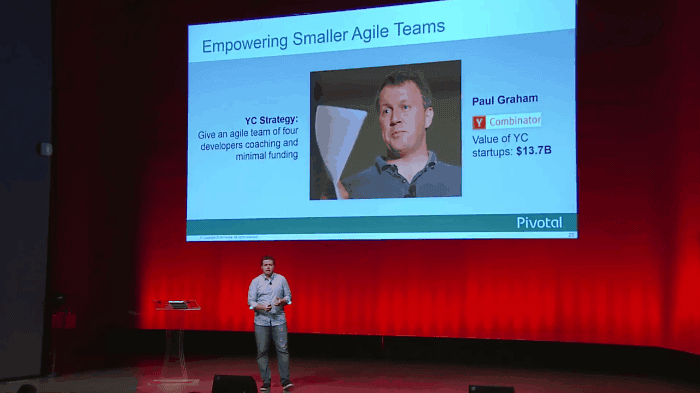What Is an Enterprise PaaS with Cloud Foundry?

To stay competitive, enterprises must ensure agility and rapid software delivery. In this video, James Watters discusses how large companies (such as Warner, Tesla, and Netflix) evolve by adopting the patterns software vendors have been using to "disrupt things."
According to James, IaaS without PaaS is a "dying breed." On top of IaaS, enterprises still need orchestration layers, data services, etc. This video highlights the problems that a PaaS solves by becoming the "operating system" of a cloud. In addition, James compares monolithic apps with the microservices approach, where "decomposing" dev teams enables them to update different parts of apps simultaneously and roll out releases faster.
James Watters and the Third Platform
The Third Platform is real, and enterprises large and small need to embrace it. This was an overarching message presented by James Watters, VP of Platform Group at Pivotal, in his presentation, “The Journey to Enterprise PaaS.”
“The patterns software companies have been using to disrupt things in a pure-play method are now coming to the enterprise.” —James Watters, Pivotal
Indeed, “software is eating the world,” he says, echoing the phrase made notorious by Marc Andreessen a few years ago.
The particular type of software upon which James focuses is, of course, PaaS, and the particular PaaS is Cloud Foundry. He notes that Pivotal is “aimed at bringing those patterns to the enterprise in a consumable way.” A big advantage for the company is that “we don’t have a legacy to protect,” he says. “We can (thus) focus on the most important trends in the market.”
James touches on much of the commonly shared wisdom of the modern age of open source and cloud computing:
- Enterprises must be agile, with rapid software delivery.
- Rapid iteration is part of this process.
- Focus on horizontal scalability.
- Big data is affecting the way companies are thinking about their businesses.
- Deep insights come to companies who collect and aggregate their data assiduously.
“It all begins with this agile process (and) gives you competitive advantage. If you can’t change what you’re doing, then you might have made the wrong bet, (because) no one’s smart enough to know 8 months or a year in advance (of exactly what they should do) and get it perfect.” —James Watters, Pivotal
Enterprises large and small
These thoughts have certainly penetrated the consciousness of all large enterprises in the world, and made a big impact at some of them. Watters mentions how with Cloud Foundry Warner Music has “become a software vendor.” (Read our article on how WMG adopted Cloud Foundry.)
An even more dramatic example comes from Tesla. The company’s cars are connected to a 4G network to enable automatic, remote updates, bypassing the traditional dealer network for much routine maintenance. Although it is not using Cloud Foundry, the company is definitely on the edge of enterprise innovation.
On a more centralized scale, Netflix has evolved from relying on its original data center, built on virtualized IBM P Series hardware, to a PaaS-style orchestration of workloads on AWS.
Watters points out that “this pattern has been happening in smaller companies, too. They’ve learned to build value over the past five years of the cloud era.”
“PaaS codifies things to make middleware, data services, an application ‘dialtone’ into API calls,” James says. “(And) Cloud Foundry has become the industry standard for PaaS.” He mentions the creation of the Cloud Foundry Foundation and notes that it is “not made up of a bunch of upstart web companies, but actually from the Who’s Who of the Tech 100. As a cohesive open-source community, we feel we can change the way enterprises do IT.”
James backs this assertion with a quote from Jonathan Rosenberg, CTO and VP, Collaboration at Cisco.
James backs this assertion with a quote from Jonathan Rosenberg, CTO and VP, Collaboration at Cisco, who has said “Cloud Foundry is the operating system of the cloud. As the set of API’s and services for PaaS’s grow, the choice of PaaS becomes more crucial as the costs of porting go up. This is one of the benefits open-source PaaS offerings like Cloud Foundry.”
As an example, Cisco’s latest generation Webex is built using Cloud Foundry.
“IaaS without PaaS is a dying breed…Change is in the air.” —James Watters, Pivotal
At this point in his presentation, he first points out that the Third Platform will have a significantly stronger compound annual growth rate (CAGR) over the next several years than traditional IT, and that Pivotal is “EMC’s Third Platform company.”
Now come microservices
Within this context, the recent interest in microservices vs. monolithic architecture is enhancing the benefits of a PaaS-based approach. “By decomposing (into microservices) you’re able to have a team working on each microservice,” James says. He cites Bank of America’s recent interest in Cloud Foundry, as it aims to direct its $7 billion annual IT budget towards a culture in which features can be added faster. They’re asking, “How do we decompose our teams? How do we organize technology teams around this?” according to James.
Pivotal’s confidence in Cloud Foundry extends to inhabiting the world of the Amazon AWS public cloud. “Cloud Foundry is the first (instance) where there’s really a choice to take this next-generation application architecture and run it in the enterprise,” he says. He provides a helpful slide that illustrates the available services (can be seen below).
Four pillars
In the final analysis, there are four general pillars upon which to build a commitment to PaaS and Cloud Foundry, James says:
- Keep developers happy (through
cf push). - Keep operations and IT teams excited. When you deploy, the application should be ready to operate.
- Keep CTOs happy. They want to use new technologies such as NoSQL services, and Cloud Foundry enables them to do so.
- Keep the CFOs happy. They are continuously trying to plan the next series of investments. With Cloud Foundry, you can deploy and manage on any infrastructure of your choice. You don’t have to decide to be all Amazon, all data center, or all Google, for example.
Is Cloud Foundry a silver bullet?
Although Cloud Foundry will dramatically speed up application delivery cycles and make life much easier for development and operations teams, it is not a magical solution that suits everyone:
- If you need the best possible performance—e.g., you have a gaming platform—and work hard to shave off every millisecond, Cloud Foundry might not be the best option. Although it drastically reduces the amount of effort and time for building applications, this may come at a price of slight reduction in performance.
- At the moment, Cloud Foundry does not run on bare metal, so you have to have an IaaS layer.
- To reap all the benefits of Cloud Foundry, you need to change the entire approach to software delivery in your company.
"IaaS without PaaS is a dying breed," James asserts here. This truism leads to the question of how aggressive (and successful) the big IaaS providers can be in thwarting Cloud Foundry's dreams, forcing their own platforms down enterprise throats, and leading us into an era of Vendor Lock-in 2.0.
James is quotable and profound here, as always. His most important advice is deceptively simple, i.e., keep everyone happy. It's very tempting to handwave Cloud Fundry and other newish tech into an enterprise on the theory that higher-ups simply won't understand it well enough to appreciate it. Big mistake, as James points out.
Want details? Watch the video!
In this video, James Watters talked about the capabilities and features that a PaaS platform has opened up for enterprises.
Table of contents
|
Below are the slides from James’s presentation.
Further reading
- Lockheed Martin Delivers Apps with Cloud Foundry in Weeks Instead of Months
- Garmin Develops New Products, Increases Uptime with Cloud Foundry
- Huawei CaaS Deploys 4,500+ Apps with Cloud Foundry









